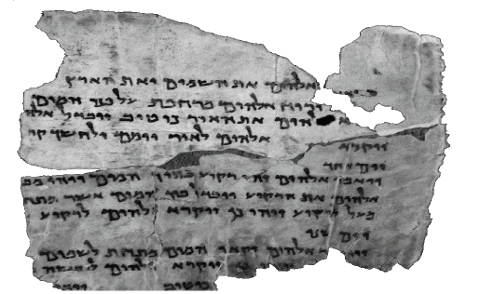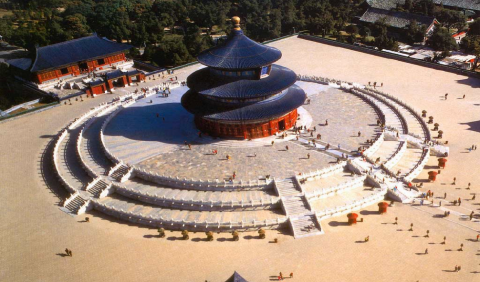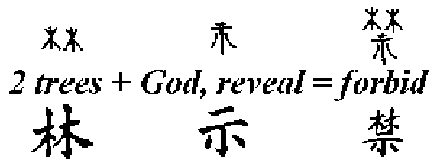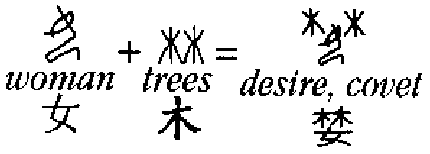In the Beginning - Shang Di?

Figure 1 - Scroll fragment containing Genesis from Dead Sea scrolls
The first five books of the Bible are commonly attributed to Moses and are commonly called the Pentateuch (literally "five scrolls"). Moses is believed to have lived between 1500 and 1300 BC. However, the earliest known surviving manuscripts of the Pentateuch, the Dead Sea Scrolls, discovered between 1946 and 1956 in caves about a mile inland from the northwest shore of the Dead Sea, were discovered more than 1000 years later. Figure 1 shows one of the oldest known Scroll fragments containing Genesis, dating from the late Hasmonean Period, 100-1 BC. 1 However, long before the birth of Moses, in what is called the “Legendary Period” of Chinese history (preceding 2205 BC), the Chinese were already writing about and offering sacrifices to ShangDi, the supreme God, at Mount Tai in Shandong Province, at the eastern border of China (Shang Shu). The Border Sacrifice, as this ceremony came to be called, continued as China’s longest celebrated and most colorful sacrifice until 1911 AD. 2 This Border Sacrifice was so important to the great philosopher Confucius (551-479 BC) that he considered it key to the efficient rule of the Chinese Empire.
“He who understands the ceremonies of the sacrifices to Heaven and Earth...would find the government of a kingdom as easy as to look into his palm!” - Confucius 3
The Border Sacrifice
The Chinese honored ShangDi by building the Temple of Heaven in the Forbidden City in Beijing (Figure 2). The Heaven-Worshipping Altar was a great, three-tiered, white marble altar of “Heaven,” 75 meters in diameter, surrounded on each level by white marble railing. In the center of the top tier was placed one circular stone called the Heavenly Heart Stone. The monumental undertaking of its construction was completed in 1530 AD. During the Border Sacrifice the emperor often offered an unblemished bull and sometimes a beautiful sheep to ShangDi in a ceremony very similar to ancient Hebrew sacrificial ceremonies. The ancient Chinese comprehended the importance of atoning for personal sin, before a just and righteous Creator, through the act of sacrificing an unblemished lamb or sheep (see John 1:29 below).

Figure 2 - Temple of Heaven, Beijing, china
ShangDi
The Chinese Classics such as the ShangShu, Shi Ji, Y Zing, And Shi Zing, written thousand years before Christianity came to China in about AD 620 4 revealed attributes of ShangDi that are consistent with that of Yahweh, the God of the Hebrews. First, ShangDi is the creator of the universe, including humankind. Second, the order of creation, starting from heaven, then earth and all living things, and finally man and woman, is the same as that of the book of Genesis. Third, ShangDi is just and demands the highest moral standard from the Emperors and His people. Fourth, He is a personal God that seeks to communicate to His people through the high priest, the emperor. The emperors were to inquire from ShangDi about His blessing to the Chinese people. No personal benefit was asked by the emperors during the offering to ShangDi at the Border Sacrifice. Fifth, ShangDi is a spirit and the making of statues was strictly forbidden. Sixth, ShangDi desires animal sacrifices, especially the bull and the lamb. 5 Curiously, one of the Hebrew names for God, El Shaddai, is phonetically similar to ShangDi, and even more similar to a earlier pronunciation of ShangDi, “djanh-tigh” [Zhan-dai]. 2
Oracle Bones

Figure 3 - Shang Dynasty "Oracle Bone"
The original Chinese writings consisted of combinations of pictographs that were based upon concepts or knowledge commonly held and understood at the time. As time has passed, the original meaning of these characters has been lost or blurred, along with the original identity of ShangDi. Further, scribes through the centuries have used stylistic variations of the characters, resulting in many ways of writing a single character. Consequently, most of today’s Chinese characters are very different from the early pictographs. Further compounding the interpretive difficulties, the first and subsequent Chinese dictionaries were written after 121 AD, long after the ancient religious belief in a single Creator God, ShangDi, had been replaced by the ideas of Taoism (or Daoism).6 Thus, the original intentions of the inventor were not likely to have been accurately captured by these dictionary authors. Then, in 1899, while visiting an herbal shop, a specialist in Chinese writing happened to identify some ancient pictographs (picture words) carved into bones that were being ground and used for medicine. The source of these bones, was traced to a site in Anyang, Henan Province that is now recognized as the “Ruins of Yin,” the last capital of the Shang dynasty (1600-1046 BC). At and around this site, archeologists have discovered well over 150,000 “oracle bone” specimens representing the earliest known body of Chinese writing among the foundations of palaces and ritual sites. They are refered to as “oracle bones” (Figure 3) because they are mostly divinations (e.g., questions to God regarding future weather, crop planting, the fortunes of members of the royal family, military endeavors, and other similar topics) inscribed on bones—turtle shells, ox scapulae, or other bones. 7
Godʼs Promise to the Chinese
About ten years ago, I first read the publication by this title written by Nelson, Broadberry and Tong Chock, published in 1997, but decided to take a “wait and see” attitude towards its intriguing premise, that ancient Chinese characters are remnants of illustrations that reflect the Bible and strongly suggest a common origin for the Chinese and Hebrew/Jewish cultures. After watching a sermon on this topic, “God in Ancient China,” by Kong Hee, a Pastor in Singapore, 8 which was very well received by an audience of over 1000 Chinese-speaking people, I decided to stop waiting, and see. In my investigations, I was impressed by Dr. Don Batten of CMI and his well reasoned responses to a skeptic. 9 Dr. Batten points to “consistent pattern in hundreds of characters, and especially in the earliest forms of Chinese writing that are preserved on pieces of bone (‘oracle bones’).” This topic has not faded away. On the contrary, the evidence that suggests a common origin for the Chinese and Hebrew/Jewish cultures appears to have grown stronger.
With the help of a well organized web review, including images, of the work of Dr. Nelson and colleagues by Dr. Edmond W. Holroyd, III, 10 I was able to pull together the following summary, focusing on the most convinving interpretations from the “God’s Promise to the Chinese” publication. 11 Most of the pictographs are from the ancient “oracle bones,” dating from the Shang dynasty. At that time, the Chinese writing consisted of simple pictographs as well as compound pictographs (combinations of pictographs). In some of the presentations below, a “traditional” (modern) version is drawn under the older “oracle bone”version.
Genesis 1:1, “In the beginning God created the heavens and the earth.”(NIV)
There are two oracle bone versions of Shang Di, ![]() . The second version has a 3-fold design, possibly suggesting mouths
. The second version has a 3-fold design, possibly suggesting mouths ![]() or persons, reflecting the Christian concept of 3 persons in the one God, the Trinity.
or persons, reflecting the Christian concept of 3 persons in the one God, the Trinity.
Chapter 3 of God’s Promise to the Chinese 6 and Dr. Holroyd’s website provide more detailed analyses of the components of these God symbols.
The Chinese also have a way of avoiding the direct mention of God. Tian means heaven (where God dwells), but tian also mean sky, overhead, day, and season. The ancient form was built using a character for a great or noble man and the character for above:

Genesis 2:7, “Then the Lord God formed a man from the dust of the ground and breathed into his nostrils the breath of life, and the man became a living being.” (NIV)

Dr. Nelson finds God’s hands taking the dirt (earth, clay) and molding it, as on a potter’s wheel, producing a man who is initially holy (set aside for a special purpose) and perfect.

Dr. Nelson finds a man arising from the dirt (earth, clay) as great and good.

God imprints his image on the first man.
Genesis 2:18-25, Creation of Eve, the first woman

(tuo/appropriate, proper)
God’s hands (shou) prepared a woman (nu) suitable (tuo) for Adam. None of the animals created by God and named by Adam was suitable for him.
Genesis 2:15-17, “The Lord God took the man and put him in the Garden of Eden to work it and take care of it. And the Lord God commanded the man, ‘You are free to eat from any tree in the garden; but you must not eat from the tree of the knowledge of good and evil, for when you eat of it you will surely die.’” (NIV)

(jin/forbid)
God gave just one command to the first people and it involved trees and obedience. The “knowledge” obtained from the forbidden tree would not be simply intellectual, but experientially knowing bad and evil. The perfection and goodness that God created would be lost.

(fu/not)
Satan came as a serpent wrapping around the two special trees. The resulting Chinese character, now showing only the tree trunks, expresses a very negative situation.
Genesis 3:6, “When the woman saw that the fruit of the tree was good for food and pleasing to the eye, and also desirable for gaining wisdom, she took some and ate it. She also gave some to her husband, who was with her, and he ate it.” (NIV)

(lan / covetous, greedy)
The woman was looking at the forbidden tree and desiring its forbidden fruit.
Genesis 3:17-19, “To Adam he said, ‘Because you listened to your wife and ate from the tree about which I commanded you, “You must not eat of it,” Cursed is the ground because of you; through painful toil you will eat of it all the days of your life. It will produce thorns and thistles for you and you will eat the plants of the field. By the sweat of your brow you will eat your food until you return to the ground, since from it you were taken; for dust you are and to dust you will return.’” (NIV)

(sang/death, funeral, mourning)
The traditional character still retains the two mouth symbols, but the simplified version has only two short lines in their place. That diminishes the impact of having two mouths and multiple hands in a tree creating a meaning of death, the consequence that God stated for the disobedience.
The spiritual death and separation from fellowship with the perfect God was immediate. The physical death came later. (The Hebrew reads, “dying, you will die;” it is a process leading to the final stoppage.)
God placed curses on the serpent, the woman, and the man, and these curses affected the rest of creation as a byproduct.
God’s curse for Adam:
John 1:29, “The next day John saw Jesus coming toward him and said, ‘Look, the Lamb of God, who takes away the sin of the world!’”
It is apparent that the ancient Chinese understood the concept of sin and the need to resolve the resulting conflict between God and themselves. The use of lamb as a reconciliation for sin is dramatically revealed in the character meaning righteousness.
God likely sacrificed a sheep or a lamb as a preview of the eventual sacrifice of the Lamb of God who would take away the sin of the world. In God’s sight. Jesus Christ is that lamb (Lamb of God; John 1:29), sacrificed for us.

The sheep is placed above me. The position of the sheep is significant and it suggests that the source of righteousness comes from the sheep.
Genesis 4:15, “But the Lord said to him, ‘Not so; if anyone kills Cain, he will suffer vengeance seven times over.’ Then the Lord put a mark on Cain so that no one who found him would kill him.” (NIV)

The Oracle Bone figure ![]() clearly shows the marked elder brother grabbing his brother to kill him. Some of that detail is lost in the traditional version, but the mark is still present.
clearly shows the marked elder brother grabbing his brother to kill him. Some of that detail is lost in the traditional version, but the mark is still present.
Genesis 7:7, “And Noah and his sons and his wife and his sons’ wives entered the ark to escape the waters of the flood.” (NIV)
Dr. Holroyd notes that Dr. Nelson lists two intermediate versions of the Traditional character for a large boat, ![]() and
and ![]() . So the upper right character has slowly changed from specific
. So the upper right character has slowly changed from specific ![]() (ba/eight) to the more general Simplified
(ba/eight) to the more general Simplified ![]() (ji/few, some, several). Dr. Holroyd believes that it is very significant that the original version has character components for 8 people, indicating that “when the ancient Chinese wanted to come up with a character to represent a big boat, they thought of the biggest boat that existed up to that time, and that was the boat that held eight people and pairs of all the animals.”
(ji/few, some, several). Dr. Holroyd believes that it is very significant that the original version has character components for 8 people, indicating that “when the ancient Chinese wanted to come up with a character to represent a big boat, they thought of the biggest boat that existed up to that time, and that was the boat that held eight people and pairs of all the animals.”
Dr. Nelson and her colleagues, as well as Drs. Batten and Holroyd, have made what I believe to be a strong case that Christianity has the same spiritual roots as the Chinese faith in Shang Di. The two cultures would have had a common origin before the dispersal of the nations from Babel (Genesis chapter 11) and would have worshipped the same God, but with different languages after that separation. As Dr. Holroyd describes,
The God presented in the Bible chose to work out his eternal plans through a particularly troublesome people group, the Israelites and Jewish descendents. They were usually disobedient and ungrateful and frequently degenerated into idol worship. Eventually God came to live among them in the person of Jesus Christ. Jesus lived a perfect sinless life as he taught God’s way of living and performed many miracles. Eventually Jesus Christ offered himself as a pure living sacrifice to pay for the sin of the entire human race. His resurrection from the dead was proof of God’s successful accomplishment of paying our sin debt in full. Since then the Christians have been under the command to spread the news of that accomplishment to all people groups.
Perhaps Christian missions to China would benefit from the knowledge that Christianity is not a foreign religion to the Chinese. It is a restoration of the worship of Shang Di. As Dr. Holroyd suggests, “The future greatness of the Chinese will be related to the degree to which they can recover the Mandate of Heaven ![]() (Tian Ming) of the original Chinese dynasties through the genuine worship of the true Creator God."
(Tian Ming) of the original Chinese dynasties through the genuine worship of the true Creator God."
- 1The Leon Levy Dead Sea Scrolls Digital Library http://www.deadseascrolls.org.il/featured-scrolls Accessed 2013 Jul 22
- 2 a b Nelson ER, Broadberry RE, Chock GT (1997) God’s Promise to the Chinese, Read Books Publisher, Dunlap, TN, ISBN 0-937869-01-5
- 3Ibid., 2
- 4Zuofeng W, (1992) China’s Way to Restoration, Chinese Overseas Christian Mission Press, Virginia.
- 5Voo KS, Hovee L (1999) The Lamb of God hidden in the ancient Chinese characters. CEN Technical J 13(1):81-91
- 6Nelson ER, Broadberry RE, Chock GT (1997) God’s Promise to the Chinese, Read Books Publisher, Dunlap, TN, ISBN 0-937869-01-5
- 7Shang Dynasty http://en.wikipedia.org/wiki/Shang_Dynasty Accessed 2013 Jul 25
- 8God in Ancient China http://www.youtube.com/watch?v=DA-AkJzpKmg Accessed: 2013 Jul 25
- 9CMI misrepresents ancient Chinese language? http://creation.com/cmi-misrepresents-ancient-chinese-language Accessed 2013 Jul 25
- 10Welcome to EdHolroyd.info http://www.edholroyd.info Accessed 2013 Jul 25
- 11Dr. Holroyd states that he summarized the most credible of Dr. Nelson’s interpretations and checked them against the Besta MT-7000 electronic dictionary and the Oxford Concise English-Chinese Chinese-English Dictionary, 1994 version. I have further reduced the number of interpretations summarized here to those that I feel are the most compelling.